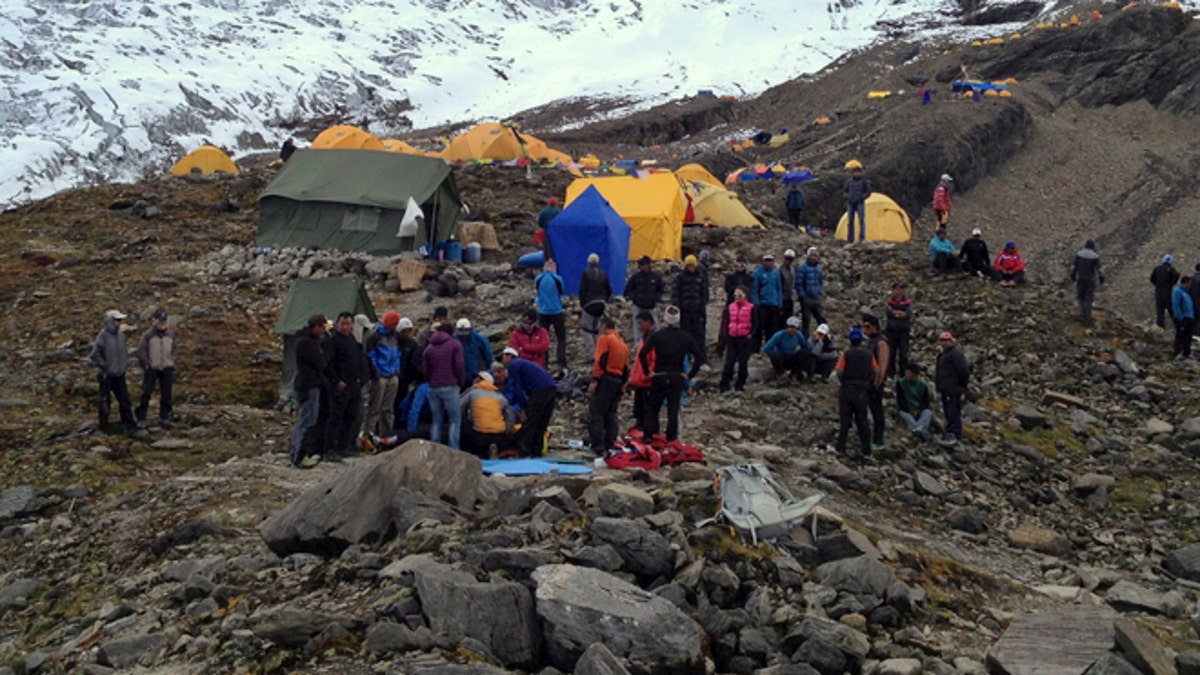
Sept. 23, 2012: In this photo provided by Nepalese airline Simrik Air, rescuers attend to injured victims, unseen, after an avalanche at the base camp of Mount Manaslu in northern Nepal. (AP)
KATMANDU, Nepal – An avalanche hit about two dozen climbers in a camp high on a Himalayan peak at the start of Nepal's autumn climbing season, killing nine and leaving six missing. Many of the climbers were French or German.
Ten climbers survived but many were injured and were flown to hospitals by rescue helicopters, police official Basanta Bahadur Kuwar said. The avalanche struck Sunday morning on the high slopes of Mount Manaslu in northern Nepal, and deteriorating weather halted air searches of the mountain by afternoon.
The peak is the eighth highest in the world. Nepal's autumn mountaineering season comes right after the end of the monsoon rains, which make weather conditions unpredictable, and is less popular than spring, when hundreds of climbers crowd the high Himalayan peaks.
The avalanche hit a camp at 7,000 meters (22,960 feet) early in the morning as the climbers were preparing to head toward the summit, which is 8,156 meters (26,760 feet) high. The cause of Sunday's avalanche was not immediately determined.
There were Italian, German and French teams on the mountain, with a total of 231 climbers and guides, but not all were at the higher camps, officials said.
Kuwar said the bodies of a Nepalese guide and a German man were recovered and rescue pilots spotted seven other bodies on the slopes. Spain's Foreign Ministry said from Madrid that one climber killed was Spanish. The identities of the others were still being confirmed.
Rescue pilot Pasang, who uses only one name, said three injured French citizens and two Germans had been transported to hospitals in Katmandu. He said rescuers were also attempting to bring the bodies of the dead back to the base camp.
Nepal has eight of the 14 highest peaks in the world. Climbers have complained in recent years that climbing conditions have deteriorated and risks of accidents have increased.
Veteran mountain guide Apa, who has climbed Mount Everest a record 21 times, traveled for months across Nepal earlier this year campaigning about the effects of global warming on the mountain peaks.
He told The Associated Press the mountains now have considerably less ice and snow, making it harder for climbers to use ice axes and crampons on their boots to get a grip on the slopes.
Loose snow also increases the risk of avalanches.
Bill Amos, of Portland, Oregon, an avid mountaineer and ice climber who founded the mountaineering apparel company NW Alpine, said "it's super sad when our fellow climbers die." Amos said his initial thought when he heard about the deadly avalanche in Nepal was that the mountain was being overcrowded with climbers.
"That seems to be the same thing that's going on in Everest," he said. "All of that is overcrowding and these commercial expeditions trying to make money."
Amos added that people who venture into the mountains need to understand the risks and dangers associated with backcountry travel and be able to spot avalanche terrain and dangerous snowpack.
